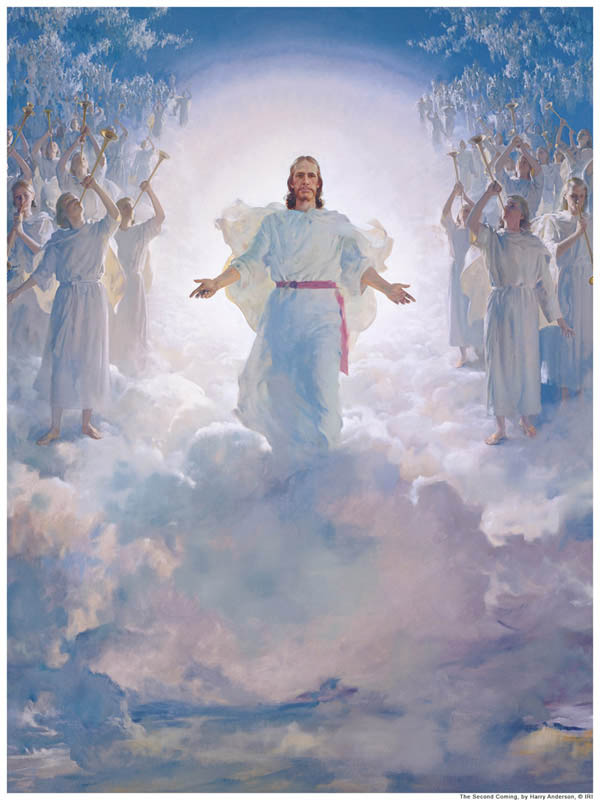In 740 B.C., Isaiah recorded this prophecy: “The earth also is defiled . . . because they have transgressed the laws, changed the ordinance, broken the everlasting covenant” (Isaiah 24: 5).
 It is clear that the prophet is speaking of generations prior to the second coming of Jesus Christ, for the next verse states: “Therefore hath the curse devoured the earth, and they that dwell therein are desolate: therefore the inhabitants of the earth are burned, and few men left” (Isaiah 24: 6). The burning of which Isaiah speaks is the same that will consume the “tares” (Matt. 13: 36-40) just before the second coming.
It is clear that the prophet is speaking of generations prior to the second coming of Jesus Christ, for the next verse states: “Therefore hath the curse devoured the earth, and they that dwell therein are desolate: therefore the inhabitants of the earth are burned, and few men left” (Isaiah 24: 6). The burning of which Isaiah speaks is the same that will consume the “tares” (Matt. 13: 36-40) just before the second coming.
The future time frame of Isaiah’s prophecy necessarily occurs in the generations after Christ’s mortal ministry, for Jesus must first establish His ordinance and covenant before it would be changed and broken centuries later.
So, which ordinance has been changed, what covenant has been broken?
A change in the ordinance of baptism is evidence in art through the ages. The painting (above) by Italian artist Sebastiano Ricci (1659–1734) has Jesus standing at a shallow edge of the River Jordan with John pouring water over His head. Why didn’t the artist depict Christ’s baptism as given in the gospel according to Mark:
“And it came to pass in those days, that Jesus came from Nazareth of Galilee, and was baptized of John in Jordan. And straightway coming up out of the water, he saw the heavens opened, and the Spirit like a dove descending upon him: And there came a voice from heaven, saying, Thou art my beloved Son, in whom I am well pleased” (Mark 1: 9-11).
The painting (right) by Spanish artist Bartolome Esteban Murillo (1617-1682) shows the same non-immersion method of baptism. But why did this artist also interpret the baptism of Jesus contrary to the account of Mark and Matthew?
” For centuries artists have helped re-write (re-paint) history by depicting the baptism of Jesus contrary to the way it is given in the gospels.
Domenico Ghirlandaio (1449-1494) of Italy
Master of the Saint Bartholomew Altar (1470-1510) of Germany
Nicolas Poussin (1594-1675) of France
Alessandro Magnasco (1667-1749) of Italy
Henryk Siemiradzki (1843-1902) of Poland
Of course, these artists did not change the ordinance of baptism; they simply mirrored the religious traditions of their day–traditions that had broken and changed from the order set forth by the Savior.
The Bible establishes two unmistakable truths about baptism:
1) Jesus was baptized by immersion, and He said “come follow me.”
2) Baptism by complete immersion under water clearly complements the symbolism taught by the Apostle Paul, of being “buried” in the grave, and then “raised“ to a newness of life.
“Know ye not, that so many of us as were baptized into Jesus Christ were baptized into his death? Therefore we are buried with him by baptism into death: that like as Christ was raised up from the dead by the glory of the Father, even so we also should walk in newness of life. For if we have been planted together in the alikeness of his death, we shall be also in the likeness of his resurrection” (Romans 6 3-5).
The word “baptize” derives from the Greek “baptizein,” meaning “to dip.” The very meaning of the word points to pouring and sprinkling methods as a change in the ordinance of baptism–departing from the way it was originally established by Christ. Because Christian traditions strayed from the Bible blueprint, Martin Luther (1483-1546) initiated the Protestant Reformation. The religious reformer wrote:
“I have sought nothing beyond reforming the church in conformity with the Holy Scriptures. The spiritual powers have been not only corrupted by sin, but absolutely destroyed; so that there is now nothing in them but a depraved reason and a will that is the enemy of God. I simply say that Christianity has ceased to exist among those who should have preserved it.”
The reformation movement led by Luther accurately pointed to the problem, but reformation was not God’s final remedy. Instead, a fresh restoration of Christ’s Church was God’s answer to apostasy.
The Church of Jesus Christ of Latter-day Saints (the “Mormon” Church) does not rely solely upon logical interpretations of ancient scripture to understand the Lord’s will and ways today; instead the LDS Church is governed by direct revelation from the head of the Church, Jesus Christ, to His latter-day prophets:
“Herein is glory and honor, and immortality and eternal life—The ordinance of baptism by water, to be immersed therein in order to answer to the likeness of the dead, . . . to be immersed in the water and come forth out of the water is in the likeness of the resurrection of the dead in coming forth out of their graves” (D&C 128: 12).


